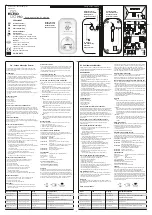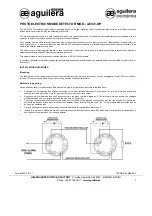
D100-55-00
1
I56-733-10
1012 Ionization and 2012 Photoelectronic
Smoke Detectors
INSTALLATION AND MAINTENANCE INSTRUCTIONS
A Division of Pittway
3825 Ohio Avenue, St. Charles, Illinois 60174
1-800-SENSOR2, FAX: 630-377-6495
Smoke Detector Description
Smoke detectors are designed to provide early warning of developing fires
at a reasonable cost. They monitor the air and can sense smoke and can
provide precious minutes for you and your family to escape before a fire
spreads. Early warning fire detection is best achieved by the installation of
fire detection equipment in all rooms and areas of the household.
Model 1012 is a low-voltage ionization-type smoke detector. Model 2012 is
a low-voltage photoelectronic-type smoke detector. The detector is de-
signed for open area protection in a residential building. Each detector has
a built-in relay which may be used to activate auxiliary devices such as
bells, horns, and door closers. The relay contacts automatically close eight
(8) seconds after the detector goes into alarm, and automatically resets
approximately five (5) seconds after the alarm stops. In addition, these
detectors can be interconnected, within one household, for a system of up
to twelve (12) smoke detectors per household. This way, when one smoke
detector sounds its alarm horn, it will cause all of the other connected
smoke detectors within the household to sound their alarm horns as well.
Installation in Australia Only
The installation temperature range for Australia is 5
°
to 45
°
C and has
been tested per the Australian Standard. Ignore installation temperatures
specified for all other applications when installing detectors in Australia.
Detectors should be installed by qualified technicians. Installation of a
main connected power supply unit must be performed by qualified electri-
cians only. Ignore the power requirements in "Smoke Detector Require-
ments" listed below, as these apply to installation in the USA. The primary
power should be provided by a power limited, supervised, panel type sys-
tem. A rechargeable battery is required as a backup to the external power
supply in case of a mains failure. In standby operation, the power limited
backup battery (fully charged) must be capable of providing uninter-
rupted power for at least 7 days to the system and all smoke alarms before
the panel gives the required low-battery signal. When the low-battery sig-
nal is given, the battery should be capable of providing power for another
7 days, after which the backup battery should have enough energy left to
allow a 4-minute alarm signal to be given by all connected smoke alarms.
Smoke Detector Power Requirements (USA)
This smoke detector will not work without power. This smoke detector is
only U.L. listed to be powered by System Sensor Part No. A77-727-01 (12-
volt DC power supply). The A77-727-01 must be permanently connected
to the building's 120-volt AC electrical supply per code. The A77-727-01
will not power the smoke detector if the AC power is cut off for any rea-
son. The 12-volt DC power supply will only power the detector when 120-
volt AC power is present—it is not a power back-up source.
Power input rating to the detector is 12VDC @ 0.02 amps. Input power to
the A77-727-01 power supply must be from a 24-hour 120V AC 60HZ cir-
cuit which cannot be turned off by a switch.
Power supply and detector
installation must conform to the electrical codes in your area and Ar-
ticle 760 of the National Electrical Code. It is recommended that wiring
be performed by a licensed electrician.
Smoke Detector Limitations
•
This smoke detector is designed for residential use only.
System
Sensor does not advise the use of this detector in multiple detector sys-
tems monitored by a central control. This detector is self-restoring and
does not lock into an alarm condition.
•
Smoke detectors will not sense a fire if the smoke does not reach
the sensor.
In order for a smoke detector to sense smoke, it must be
installed in the immediate vicinity of the fire. In addition, smoke from
fires in chimneys, in walls, on roofs, in remote parts of the building, or
on another level from where the smoke detector is located, may not
reach the smoke detector quickly enough for occupants to escape un-
harmed.
For this reason, installer shall install smoke detectors on
every level, in every sleeping area, and in every bedroom of the
household.
•
Smoke detectors may not be heard.
The alarm horn in this smoke de-
tector meets or exceeds current Underwriter's Laboratories standards.
However, if the smoke detector is not located in the same room as the
occupant, or if it is blocked by a closed door or normal noise, the
alarm horn may not be heard. In addition, sound sleepers, or persons
who are under the influence of drugs or alcohol may not hear the
alarm or be able to react to it.
Therefore, locate this smoke detector,
which has a sounder rated at 85 dB at 10 feet, on every level, in ev-
ery sleeping area, and in every bedroom of the household.
•
In general, detectors may not always warn you
about fires caused by
carelessness and safety hazards like smoking in bed, violent explo-
sions, escaping gas, improper storage of flammable materials, over-
loaded electrical circuits, children playing with matches, or arson.
•
Smoke detectors are not fool-proof.
Like all electronic devices, smoke
detectors have limitations. No type of smoke detector can sense ev-
ery kind of fire every time. In addition, smoke from slow, smolder-
ing fires rises slowly and may not reach the smoke detector until
actual flame breaks out. This type of smoke may not reach the
smoke detector in time for occupants to escape unharmed.
•
Smoke detectors are not a substitute for life or property insurance.
Though smoke detectors have been responsible for saving many lives,
they are not warranted or implied to protect lives or property in the
event of a fire.
•
Smoke detectors have a limited life.
They contain many parts. Any of
these parts could fail at any time. Repair or replace the smoke detector
immediately if the alarm horn does not sound when tested.
Do not, in
any case, use a smoke detector for more than 10 years from the date
of original installation.
Where to Install Smoke Detectors
Warning:
As a minimum requirement, smoke detectors must be installed
in accordance with the National Fire Protection Agency (NFPA) Standard
72 which defines the standards for the National Fire Alarm Code (National
Fire Protection Association, Batterymarch Park, MA 02269-9101). In addi-
tion, observe all local and national building and electrical codes.
Proper Detector Location:
Figure 1: Recommended smoke detector protection for single-
floor residence with only one sleeping area
DINING ROOM
KITCHEN
BEDROOM BEDROOM
BEDROOM
LIVING ROOM
SMOKE DETECTORS FOR MINIMUM PROTECTION
SMOKE DETECTORS FOR MORE PROTECTION AND
REQUIRED IN NEW CONSTRUCTION
A78-1171-01






















